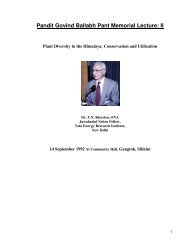Pt. Govind Ballabh Pant Memorial Lecture : XI
Pt. Govind Ballabh Pant Memorial Lecture : XI
Pt. Govind Ballabh Pant Memorial Lecture : XI
- No tags were found...
You also want an ePaper? Increase the reach of your titles
YUMPU automatically turns print PDFs into web optimized ePapers that Google loves.
clumps with over 200 culms suggest that an exponential growth rate ofup to 10 percent a year could very well have been maintained from theestablishment of the clump at the age of 8—10 years until the age ofseeding of 45-50 years (Rawlinson 1931).Big bang floweringBamboos are, all said and done, grasses. Most grass species sproutwith the rain and seed and die en-mass as the monsoon draws to a close.Many bamboo species too enact this drama, but as befits trees, theystretch it out over decades. In fact, 70 out of 72 of the Indian bamboospecies possess a long period of vegetative growth followed by a singleburst of reproduction, ending in death. Only about eight of these 70monocarpic species exhibit synchronized or mast seeding of all clumpsover an area of several hundred square kilometers. Of the twocommonest species of the Western Ghats, Bambusa arundinacea, whichforms dense stands along water courses in areas of less variable rainfall,belongs to this minority of mast seeders; Dendrocalamus strictus, whichoccurs in scattered numbers in areas of more variable rainfall, exhibitssporadic seeding behavior. Observations on the synchronized seedingof B. arundinacea show it to be spread over 5-6 years, with flower andseed production by any individual clump being completed over the dryseason from December to April (Gadgil and Prasad 1984).Our observations at Sampaji in coastal Karnataka revealed that aB. arundinacea clump produces an astronomical number of flowers. Ateach node of a culm there was an average of 133 spikes, and each spikehad an average of 156 flowers. Since a single culm had an average of 65flower-bearing nodes, each culm bore some 1.3 million flowers. Someof the bigger clumps had as many as 52 culms in this population; B.arundinacea clumps with as many as 200 culms have been recorded. Thus,even in this population, a single individual produced as many as 68million flowers. About three quarters of the seeds had no endosperm,so that each bamboo culm produced about 3 lakh fully developed seeds.With seed weighing 0.012 g, this comes to a seed production of 3.6 kgper culm, or around one quintal for an average clump with 23 culms.Like most other grasses, bamboos produce seeds that are highlypalatable to a number of animals, including partridges, junglefowl,rodents, deer, wild pigs and possibly the Indian elephant, as well as8











